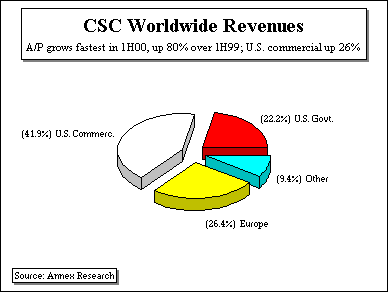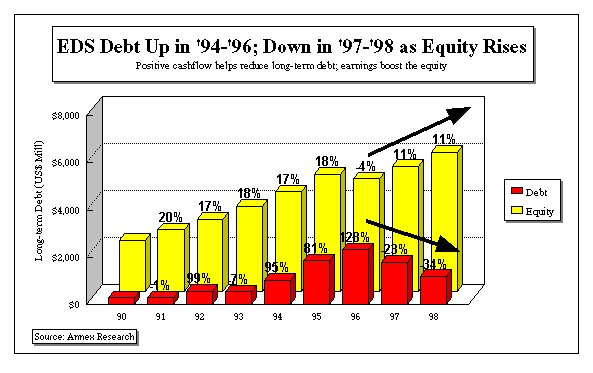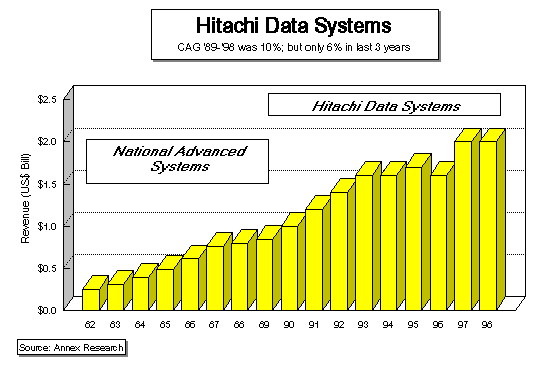
Analysis of Electronic Data Systems' 1998 Business Results
Growth Slows,
Equity Grows
New
Contracts Down from 4Q97; Suing a "Mega Customer" (Xerox)

WESTERN AUSTRALIA, Feb. 4 - Two of Ross Perot's brainchildren - Electronic
Data Systems' (EDS) and the newly public issue of Perot Systems (PS) - were the
only two major technology companies to see their stocks rise in anticipation of EDS'
fourth quarter financial release after the markets closed on Thursday (Feb. 4). EDS was up
3/8 to $52, while PS increased 4 3/16 to $66 1/16, more than a four-fold jump in the first
two days of trading.
And after all the write-downs, write-ups (reversals of previous write-downs) and other
one-time adjustments are made to EDS' latest business results, the big picture which
emerges is that the growth slowed in the fourth quarter, while the shareholders equity
increased. In other words, seekers of "bad news" stories should look at EDS' on
its income statement; those looking for "good news" angles should concentrate
balance sheet. We'll do both, as usual, starting with the income statement…
Income Statement. Fourth quarter revenues were up a meager four
percent including a one-time negative adjustment of $200 million, most of which related to
the 1994 Xerox $3.2 billion "megadeal." But even without this adjustment, the
nine percent increase is nothing to write home about, especially in view of the surging
business volumes reported by IBM and Cap Gemini, two of the four top EDS
competitors, during the same period (see Annex Bulletins 99-02, 1/22/99, and 99-03,
1/29/99).
EDS' loss of market share was also evident in its fourth quarter new contract sales.
They were "only" $2.5 billion, less than half that which the company reported in
the fourth quarter a year ago ($5.8 billion). And during the same three months, IBM closed
$9 billion of new deals, outselling EDS by almost a four-fold margin. For the full year,
IBM outsold EDS by almost a three-fold margin ($33 billion vs. $11.8 billion).
Clearly, the recent turmoil at the top of the house (Les Alberthal's and Gary
Fernandes' retirements) has negatively affected EDS' new business sales
performance. It's all reminiscent of the first half of 1996, when the company's sales
suffered while the top management took its eye off the ball, focusing on its divorce from General
Motors (GM), rather than on generating new business (see Annex Bulletins 96-FB7,
4/22/96 and 96-FB10, 7/16/96).
 Unlike in
1996, however, when the stockmarket failed to take notice of such EDS problems for almost
six months (see Annex Bulletin 96-51, 10/23/96), it is doubtful that Wall Street will be
as forgiving when the market opens tomorrow (Feb. 5). Especially considering that EDS' new
chairman and CEO, Dick Brown, predicted during the post-release
teleconference with analysts that the $4.2 billion revenue which the company derived from
GM last year, is likely to drop by 7%-10% in 1999. The GM revenues declined by 3% in 1998,
after rising a meager 1% in 1997, the first full year of an independent EDS. Unlike in
1996, however, when the stockmarket failed to take notice of such EDS problems for almost
six months (see Annex Bulletin 96-51, 10/23/96), it is doubtful that Wall Street will be
as forgiving when the market opens tomorrow (Feb. 5). Especially considering that EDS' new
chairman and CEO, Dick Brown, predicted during the post-release
teleconference with analysts that the $4.2 billion revenue which the company derived from
GM last year, is likely to drop by 7%-10% in 1999. The GM revenues declined by 3% in 1998,
after rising a meager 1% in 1997, the first full year of an independent EDS.
Despite such a GM shortfall, Brown also said that he expected double-digit revenue
growth in 1999. Which means that the company's commercial side of the business, the
so-called "base" revenue which accounted for three-quarters of the total, will
have to rise by at least 17%. In 1998, the "base" revenue was up by about that
much (16.5%), so the challenge isn't all that great.
But EDS will have to grow by a lot more than that in 1999 if it is to make up the
ground it had lost to the rivals in 1998. The big win of a $1 billion, seven-year the
state of Connecticut "megadeal" over its top competitors (IBM, CSC), which EDS
locked up in the waning days of December, will give the company a good push in that
direction. Especially as the company was also named as a finalist in two other
"megadeals."
As for EDS' bottom line, its net income for the full year, including all the
adjustments, was $743 million, up slightly (2%) over 1997. But adjusted for a lower 1998
tax rate (34.4% vs. 36%), EDS' net was actually down 1%.
During the analyst conference, Brown refused to forecast the EDS future earnings,
showing that he is quickly learning from his predecessors mistakes.
 EDS' gross
profit also rose about 2% in 1998, but its gross margin dropped 1.5 points to 17.3%,
roughly the level it was at in 1996, the year which included a half-a-billion-dollar
charge related to its GM divorce. Since the peak in 1993 (24.9%), EDS has now lost 7.6
gross margins points. EDS' gross
profit also rose about 2% in 1998, but its gross margin dropped 1.5 points to 17.3%,
roughly the level it was at in 1996, the year which included a half-a-billion-dollar
charge related to its GM divorce. Since the peak in 1993 (24.9%), EDS has now lost 7.6
gross margins points.
EDS' operating profit was down 12% to $1.1 billion, for a 6.3% operating margin, down
from 8% in 1997.
In short, EDS' income statement will need a lot of tender loving care and attention by
the company's top management. in 1999 and beyond.
Balance Sheet. As to EDS' "good news" stories, the
company's balance sheet provides several of them.
First of all, the equity, the bottom line from the shareholders' standpoint, was up 11%
in 1998 to $5.9 billion. Second, long-term debt was down by 34% to $1.2 billion. Third,
thanks to the positive cashflow generated by operations, and the fact that EDS' management
didn't squander its earnings on stock buybacks as IBM's did, EDS' cash was up by 28% to
$1.3 billion.
But all of the above, of course, is business substance. At a time when the stockmarket
seems to prefer to trade on "fluff," it remains to be seen how much slack
investors will cut EDS on account of its "good news" balance sheet stories.
Suing a Big Customer
When EDS won the Xerox $3.2 billion megadeal in 1994, Xerox CEO, Rick
Thoman, a close friend and confidant of IBM chairman Lou Gerstner,
was then an IBM executive. Naturally, back then we had no idea that one day, EDS and Xerox
would lock horns in a court battle. After all, it's not every day that you see a major
company sue one of its biggest customers in a "megadeal" dispute. The last time
EDS was forced to do it was in 1992, when it sued the state of Florida. That dispute was
eventually settled in 1995 through arbitration. Citing confidentiality clauses in its
Xerox agreement, EDS said that it couldn't comment on the latest lawsuit.
But even without the benefit of today's hindsight, we warned in 1994 that the Xerox
deal could be a Pyrrhic victory for EDS. It may temporarily boost the company's revenue
and new contract sales, but it may also hurt its long-term margins. For, the hotly
contested "megadeals" are often like the game of chicken: The last bidder to say
"no" gets stuck with the deal. Here's an excerpt from the Annex Bulletin 94-46
(10/19/94):
"In each case, EDS 'won' over IBM and other competitors.
The third quarter (of 1994) was the first period in which the benefits from these two
"megadeals" were supposed to figure materially. They did. The net effect was
that EDS' gross profit margins dropped from 25% to 23%. The operating margins declined
from 14% to 12%.
Compared to the rest of the I.T. industry, such bottom-line
results are, of course, terrific. As is EDS' net margin of 8.3%. But in each case, the
latest results are lower than those previously reported. For the thrifty, margin-conscious
EDS shareholders, if not for its growth-crazed management, they ought to sound a few alarm
bells. And prompt questions such as - 'is EDS' buying the business'?"
For prior to winning the Xerox deal in March 1994, EDS was on an 11-deal losing streak
against IBM in North America. As an IBM executive put it back then, "it was just a
matter of time and place before EDS went deep' (i.e., 'bought the business,' see Annex
Bulletin 94-14, 4/01/94).
"Nobody actually asked EDS' chief financial officer, Jody
Grant, that question during this morning's teleconference with (mostly) Wall Street
analysts. But he tried to ward it off, anyway. 'We've been reasonably dominant in our
ability to win against IBM,' he opined.
Sure… (EDS) may check with the mainframe PCM executives.
They also thought (for a while) that they could 'buy the business.' Until they almost got
bought out themselves (in Hitachi's case - almost literally; in Amdahl's - nearly - yet,
still counting...)."
[As it turned out, Amdahl was also taken over - by Fujitsu in 1997 - see Annex Bulletin
97-32, 7/31/97].
Hitachi's Buyout
Speaking of buyouts, as predicted last fall, this week Hitachi bought out EDS'
16% share of Hitachi Data Systems (HDS) reportedly for just under $50 million,
ending a 10-year partnership. The price implies that, HDS, the $2 billion-dollar Hitachi
subsidiary, is worth only about $300 million, less than it was ten years ago, when Hitachi
and EDS bought the $850 million NAS from National Semiconductor.
 Nor is its
parent (Hitachi) in much better shape. Here's an excerpt from the Annex Bulletin 98-38
(10/30/98) followed by the latest news: Nor is its
parent (Hitachi) in much better shape. Here's an excerpt from the Annex Bulletin 98-38
(10/30/98) followed by the latest news:
"HDS was formed in May 1989 as a result of
Hitachi's takeover of NAS (National Advanced Systems) from National Semiconductors. Which,
in turn, was a result of NatSemi's takeover of Itel Corp., whose last rites were read, and
the death certificate issued in September 1979.
And so, does a failure beget a failure, which begets a failure?
Not if you look at HDS' sales figures. Especially its early years. The company has grown
at a compound annual rate of 11% since 1989, to over $2 billion in its latest fiscal year,
ended March 31.
In the last three years, however, HDS' revenue growth has slowed
to only 7% annually, despite a big shot in the arm which the company received from its
"Skyline" mainframe product line. And now that IBM has not only caught up with,
but has surpassed the 'Skyline' with its CMOS servers' performance, questions about HDS'
long-term viability are starting to creep up again.
And not just that of HDS. We may be witnessing a start of a
slow-motion death not only of that Itel descendent, but maybe even of its parent - one of
the oldest and the most respected "establishment" companies in Japan - Hitachi
Ltd.
Incredible? Shocking? Yes, but not out of the question.
What are the chances of Hitachi, a $70 billion-company employing
over 330,000 people, yet facing a $1.9 billion loss in the current fiscal year, may bite
the dust in the next ten years?
'About 80%,' came back one opinion from a broker at one of the
world's best known investment bankers based in Tokyo."
In a news report just in from a Tokyo-based New York Times
correspondent, Hitachi has said that it expects an ADDITIONAL $1.1 billion loss in its
current fiscal year to those it had previously forecast. Which means that when the gong
sounds ending Hitachi's FY99 on March 31, the company will have racked up a loss of $3.3
billion - a "megaloss" even in the current gloomy Japanese economy.
Happy bargain
hunting!
Bob Djurdjevic
Other Charts
- EDS New Contracts' Value - 1991-1998
- EDS Quarterly New Contract Shares 1991-1998
- EDS Quarterly New Contract Values 1991-1998
- EDS Business Trends 1990-1998
- EDS Gross Margins 1990-1998
Tables
- EDS Financial Results - P&L 1996-1998
Also, check out "Andersen: Another
Super Year" Annex Bulletin; or "EDS
Sets New Records".
Annex Research is a well respected consulting firm serving the information needs
of today's senior IT executives, for over 28 years. For more information please call
602/824-8111.
|


![]()
 Unlike in
1996, however, when the stockmarket failed to take notice of such EDS problems for almost
six months (see Annex Bulletin 96-51, 10/23/96), it is doubtful that Wall Street will be
as forgiving when the market opens tomorrow (Feb. 5). Especially considering that EDS' new
chairman and CEO, Dick Brown, predicted during the post-release
teleconference with analysts that the $4.2 billion revenue which the company derived from
GM last year, is likely to drop by 7%-10% in 1999. The GM revenues declined by 3% in 1998,
after rising a meager 1% in 1997, the first full year of an independent EDS.
Unlike in
1996, however, when the stockmarket failed to take notice of such EDS problems for almost
six months (see Annex Bulletin 96-51, 10/23/96), it is doubtful that Wall Street will be
as forgiving when the market opens tomorrow (Feb. 5). Especially considering that EDS' new
chairman and CEO, Dick Brown, predicted during the post-release
teleconference with analysts that the $4.2 billion revenue which the company derived from
GM last year, is likely to drop by 7%-10% in 1999. The GM revenues declined by 3% in 1998,
after rising a meager 1% in 1997, the first full year of an independent EDS. EDS' gross
profit also rose about 2% in 1998, but its gross margin dropped 1.5 points to 17.3%,
roughly the level it was at in 1996, the year which included a half-a-billion-dollar
charge related to its GM divorce. Since the peak in 1993 (24.9%), EDS has now lost 7.6
gross margins points.
EDS' gross
profit also rose about 2% in 1998, but its gross margin dropped 1.5 points to 17.3%,
roughly the level it was at in 1996, the year which included a half-a-billion-dollar
charge related to its GM divorce. Since the peak in 1993 (24.9%), EDS has now lost 7.6
gross margins points. Nor is its
parent (Hitachi) in much better shape. Here's an excerpt from the Annex Bulletin 98-38
(10/30/98) followed by the latest news:
Nor is its
parent (Hitachi) in much better shape. Here's an excerpt from the Annex Bulletin 98-38
(10/30/98) followed by the latest news: